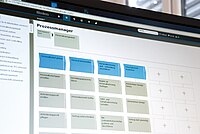WissIntra
| WissIntra | |
|---|---|
| developer | k + k information services GmbH |
| Current version | WissIntra NG (2014) |
| operating system | Windows |
| category | Business Information Framework / Quality Management / Knowledge Management |
| License | proprietary |
| language | German, available in other languages |
| www.wissintra-ng.de | |
WissIntra is software for the implementation of process-oriented quality and knowledge management based on the DIN ISO standard . The aim is to support companies in mapping business processes and their optimization in order to be able to secure long-term competitiveness. In addition, the PDCA cycle can be displayed with the tool. The software manufacturer is k + k information services GmbH from Fellbach (Germany).
overview
WissIntra is realized through the use of web technologies. The software offers the possibility of business process modeling as well as long-term documentation and binding of company-specific knowledge.
According to the manufacturer, WissIntra is used by around 250 companies with 6000 licenses both in Germany and abroad.
history
Since version 6.0, released in 2007, the program has been owned by k + k, which bought the software from the Wissgroup in 1999. The continuous further development led to the program version 6.1 in 2009 as well as the development of WissIntra SMB. This was followed by the relaunch of WissIntra 6.2 in 2011 and the publication of the subsequent version WissIntra 6.3 in 2013. At CONTROL 2014 WissIntra NG, a new development based on a completely new architecture, was presented to the specialist audience. The ending "NG" stands for the term "Next Generation". The software solution was programmed from scratch by the manufacturer, it has a modular structure and is web-based.
| 2007 | 2009 | 2011 | 2013 |
| 6.0 | 6.1 | 6.2 | 6.3 |
| Since 2009 |
| WissIntra SMB |
| Since 2014 |
| WissIntra NG |
Working principle
The software defines the business processes as independent processes. These are not static and can be broken down into any number of sub-processes, also called levels.
The system maps up to 3 nested levels. The process documentation is in tabular form, in which the individual sequential processes of the process are arranged one below the other. The process steps that arise in this way can be described individually and in detail in their tasks and supplemented with specifications.
Central method
The central component of the program is the process map. This describes a process step in all its details. A holistic definition of all relevant characteristics and information as well as the responsibilities is carried out.
The graphic representation of the process map (see figure) gives a schematic overview of the description of a process step. It creates a central knowledge carrier, which all members of a network (e.g. an intranet) can access thanks to the web-based implementation.
Areas of application
The software is traditionally used in the sense of an integrated management system. However, it can also be used for knowledge management as well as project and product management.
Demarcation
WissIntra offers the possibility of defining general as well as individual business processes centrally and depicting them with the help of a graphic representation. It thus represents in the same way a storage medium for the specific company knowledge as well as a communication channel for information between company members. The program is not automated. It neither recognizes the need for optimization nor does it actually allow real processes to run. Nevertheless, it has linkage options.
Web links
Individual evidence
- ↑ H. Hothum, U. Schmidt-Maas, H. Wünsche: Quality management in the workflow process. In: Altenheim: Solutions for Management. 5/2003, pp. 39-41.
- ↑ D. Hoffmann, P. Wintzer: Describe and optimize business processes. In: Journal for Corporate Development and Industrial Engineering FB / IE. 51st volume, issue 4, September 2002.
- ↑ A. Richter: IT-supported knowledge management theory, applications and barriers. 2nd Edition. Volker Derballa Verlag, Berlin 2008, ISBN 978-3-9811923-0-8 .
- ↑ B. Oestereich, C. Weiss, C. Schröder, T. Weilkiens, A. Lenhard: Object-oriented business process modeling with UML. dpunkt.verlag, Heidelberg 2004, ISBN 3-89864-237-2 .
- ↑ J. Trojan: Strategy for the Preservation of Knowledge - To secure sustainable competitive advantages. Deutscher Universitäts-Verlag, Wiesbaden 2006, ISBN 3-8350-0133-7 .
- ↑ Manufacturer: WissIntra NG at CONTROL 2014. (No longer available online.) In: wissintra.de. April 25, 2014, archived from the original on May 22, 2014 ; accessed on May 22, 2014 . Info: The archive link was inserted automatically and has not yet been checked. Please check the original and archive link according to the instructions and then remove this notice.
- ↑ Manufacturer: WissIntra NG ( Archived copy ( memento of the original from July 13, 2014 in the Internet Archive ) Info: The archive link has been inserted automatically and has not yet been checked. Please check the original and archive link according to the instructions and then remove this notice. ). Retrieved July 28, 2014
- ^ M. Schupp: Process management - Smarter not harder. In: MQ Management and Quality. 12/2009, pp. 21-23.
- ↑ G. Leidigkeit: Process management in the chemical industry: Now what belongs together is growing together. In: QZ. Volume 56 (2011) 12, pp. 35–37.
- ↑ L. Schimmelpfeng, S. Henn, C. Jansen: Integrated (environmental) management systems - introduction, application, certification in practice. Blottner, Taunusstein 1998, ISBN 3-89367-072-6 .




